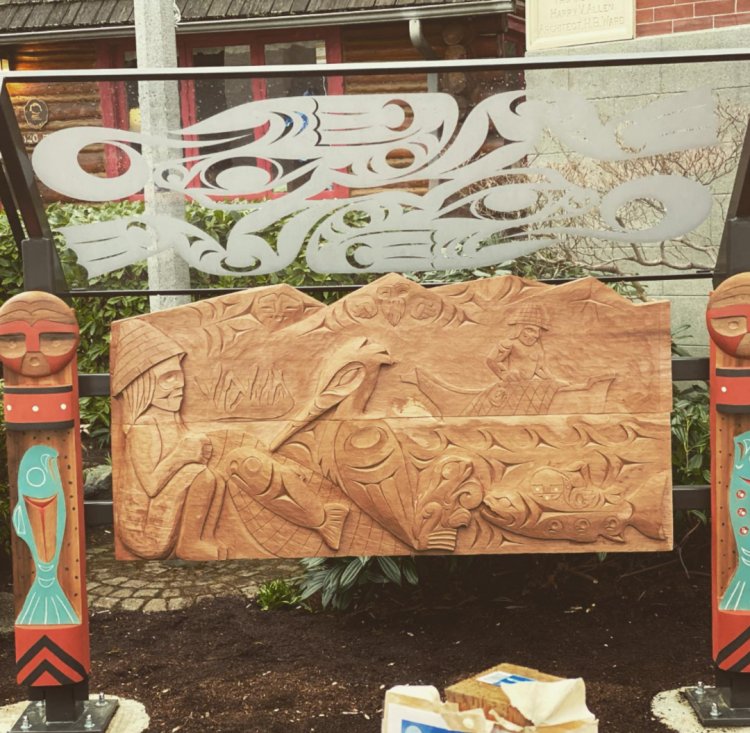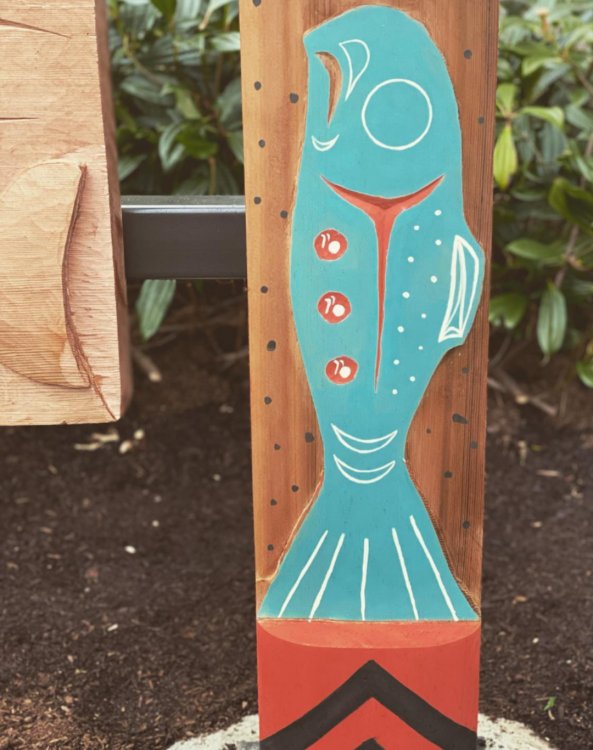Edmonds was once a vast marsh land set amid rugged forests, fruited plains, and clear-glass waters teeming with sea life — enjoyed by indigenous Coast Salish tribes for thousands and thousands of years before settlers and loggers came to stake their claim in the 1800s, driven by “Manifest Destiny.”
Salish tribes depended on the Pacific Northwest’s natural resources to sustain them through long, cold winters. They made the most of their seasonal harvests; nearly 300 species of plants, animals, shellfish and fish more than provided for their every need, as a part of their traditional, nutrient-dense diet and as medicine….cattails, reeds, roots, and berries, shellfish and salmon, fowl and game, nettle shoots, soapberry, cous root, dandelions, miles and miles of cedar for longhouses and carved storytelling.
Many of those tribes came to Edmonds in the summer to harvest, fish, and gather for fellowship and marriage.
The arrival of white settlers changed the landscape, and the diet, tremendously.
They turned Edmonds into one more logging (and farming) town, with shingle mills up and down the Puget Sound shoreline, filling blue skies with saw dust and smoke. Their claims and their (idea of) civilization forced many tribes onto reservations by 1890, forever changing an ancient, sustainable, natural way of life.
“The movement of American settlers to the West rapidly altered ecosystems and restricted access to lands and waters, making it increasingly difficult for Coast Salish tribes to harvest and maintain traditional foods. From 1854 to 1856, seven treaties, including the Treaty of Point Elliott, established the reservation system for Washington tribes, limiting access to fishing and harvesting, and drastically altering the Coast Salish diet. By 1890, most tribes had been forced onto reservations, and government restrictions limited travel and food-centered cultural practices and celebrations. A diet largely comprised of milk, pork fat, sugar, beans, and wheat became the primary option [‘Food for Thought: Revitalizing Indigenous Knowledge about Healthy Eating’ by Meghan Jernigan (Choctaw Nation) and Genevieve Wanucha, Dimensions Magazine, Fall 2019 | UW Medicine Memory & Brain Wellness Center, November 25, 2019].”
With the change in landscape and diet, came the birth of a new town established by white settlers and their new ways, in the name of Manifest Destiny and progress.
One in particular, more than anyone else, perhaps.
George Brackett, known as the founder of Edmonds proper, converted the marshlands (that sustained a multitude of indigenous tribes) into logging territory, in his image.
Originally from eastern Canada, maybe New Brunswick, the lifetime logger arrived in Western Washington, building his financial nest egg until one day in 1870, while rowing along Puget Sound shores searching for more timber, he came across what would become home for him and his family, and countless others looking for a place to land. Edmonds.
By 1876, Brackett bought up 140 acres that covered a half-mile of waterfront and the hillside above the marshes. As the years progressed, he expanded his logging empire throughout much of what is known as "The Bowl" of downtown Edmonds. In order to continue logging, he had to clear the land. That meant draining the precious marshes.
As the population grew by leaps and bounds, Brackett spearheaded the effort to incorporate Edmonds as a fourth-class village in 1890. He also became the town's first mayor that year, a role he did not take lightly.
Brackett re-envisioned and re-shaped the marshlands into a bonafide working town, with several important developments at the helm during his lifetime: the first store in 1880, first post office (he served as postmaster) and first school (in his barn) in 1884, first waterfront sawmill in 1889, roads and more infrastructure to hold up new industries, as trains and automobiles replaced the horse and buggy.
He made sure to snag automobile ferry service for his town, too, when the time came. Two and a half years prior to his passing in 1927.
After Brackett's death, his "modern city" kept evolving, in a very different direction.
Fast-forward to the turn of the century, into the next millennium...and artistic redemption.
The Great Northern Railway, State Highway 99, and Interstate 5 brought more people and more diversity to Edmonds. Their hopes and dreams, and hard work soon transformed the downtown area from 5th Ave. and Main St. outward into a unique, artist-friendly community, especially with the launch of the Edmonds Arts Festival and the Driftwood Players theater group in 1957.
The Cascade Symphony Orchestra, Olympic Ballet Theater (originally the 1972 Dorothy Fisher Concert Dancers), and the Edmonds Center for the Arts would follow in subsequent years to cement Edmonds as an arts and culture mecca, situated in one of the most beautiful landscapes in the Northwest.
“The development of a fine city parks system highlighting but not confined to the waterfront placed sculptures and other art works throughout the city and created an innovative underwater park popular with scuba divers north of the ferry landing [‘Edmonds — Thumbnail History’ by Charles LeWarne, March 27, 2008, History Link.org].”
The good people of Edmonds also sought to restore, redress, and reinvent what it means to be a diverse, environmentally conscious, arts and culture enclave. Through various programs and partnerships, leaders, officials, and volunteers sought to keep and protect what made this town so special in the first place by limiting building heights, turning Brackett's Landing into a marine sanctuary, preserving what remains of the marshes (a fantastic bird sanctuary), and other environmental spaces, and thoughtfully maintaining balance between man and nature in future land and urban developments.
More about this former logging town’s history and its movers, shakers, and civic-minded believers can be found at the Edmonds Historical Museum, when it opens. The museum was established in 1973 and is housed in the 1910 Carnegie Library building at 118 5th Ave. N.
The museum may be temporarily closed, but you can still check out some amazing art outside that continues the indigenous story of tribes and their summer villages in Edmonds.
"Coast Salish tribes usually had a winter and a summer village – with the winter village being regarded as their permanent residence, used for holding winter ceremonies from November until March – and summer villages or camps considered temporary, used for food gathering, hunting and other important survival tasks."
—"A Very Short History of the Coast Salish People" by Sophia White, Dec. 10, 2015, Culture Trip
On March 21, Coast Salish carving artist Ty Juvinel installed “Marsh Life” (pictured) on the north side of the building.
The art installation depicts the Coast Salish people's "Marsh Life," imaginatively, using tribal symbols, traditional etching techniques, and mythic storytelling traditions (frogs as spiritual signs). Two colorful, salmon-carved posts (male and female) flank a double-sided, carved cedar panel, with a reflective etched-glass cover for full effect.
Clayton Moss of Pro Forma Design added the foundational framework to properly, naturally display the compelling installation, made possible by the Edmonds Arts Festival and Hubbard Family Foundations, as well as support from other private donors.
"It's a depiction of what the marsh may have looked like before this area turned into what is Edmonds now. It's just my opinion, what it may have looked like before contact ['Honoring the Coast Salish people in Edmonds' by Brian Soergel, Edmonds Beacon, March 24, 2021]."
In Aug. 2020, Juvinel and local artist Andy Eccleshall worked together on "Before Edmonds," two murals re-imagining the lives of the Snohomish, Suquamish, Swinomish, and Stillaguamish tribes that make up some of the Coast Salish peoples — on land and sea. The murals are on opposing walls in the south alley of Fourth and Fifth Ave. S., between Bop 'N Burger and The Papery.
Edmonds Beacon (March 24) and My Edmonds News (March 21) both have features up on Ty Juvinel and his newest art carving.
The story of Edmonds winds inextricably around its mysterious, wonderful waterways, marshlands, and forests — sea to shore — and its memorable, pioneering people. History and art live here, sustaining a natural, unique, diverse way of life, harvested, nourished, and fostered by the indigenous Coast Salish Peoples and re-engineered by a white settler and logger named George A. Brackett, for better or worse.




